Long-Term Atmospheric Aging and Corrosion of Epoxy Primer-Coated Aluminum Alloy in Coastal Environments
Abstract
1. Introduction
2. Experiment
2.1. Specimens
2.2. Atmospheric Exposure Test
2.3. Micromorphological Characteristics of Surface and Cross-Section
2.3.1. Gloss, Chroma, and Contact Angle
2.3.2. Surface and Sectional Appearance
2.4. Electrochemical Measurement
2.5. Characterization of Epoxy Coatings
3. Results and Discussion
3.1. Surface Characterization
3.1.1. Analysis of Gloss, Chroma, and Contact Angle
3.1.2. SEM Analysis of Micro-Defects on the Surface
3.1.3. Fractal Characteristics of Surface Corrosion
3.1.4. AFM Analysis of Surface Morphology
3.2. Sectional Characterization
3.3. Electrochemical Characterization
3.4. Aging Characteristics of Coatings
3.4.1. TGA and DSC analysis
3.4.2. XPS analysis
4. Conclusions
- (1)
- By measuring the chroma, gloss, and contact angle of epoxy coatings exposed to the atmosphere in the long term, we found that different durations of exposure induce different characteristics of aging. The island method was used to calculate the fractal characteristics of corrosion on the surface of the coatings. The number of fractal dimensions increased with the duration of exposure. AFM was used to analyze the micro-morphology and roughness of the coating surface, and showed that the surface roughness increased gradually in the first 12 years, but decreased after 20 years of exposure.
- (2)
- After 20 years of exposure, the transport channels of corrosive ions appeared in the cross-section of the epoxy coating, resulting in the intergranular corrosion of the substrate. Significant intergranular corrosion and exfoliation corrosion occurred in the area where the coating had peeled, and the product of corrosion was Al(OH)3—as determined by EDS and XRD. With the increase in the corrosion years, the CR values representing the corrosion kinetic parameters also increased continuously, and the CR values increased by 5.2-fold compared with the uncorroded sample after 20 years of exposure.
- (3)
- TGA and DSC analyses of the epoxy coatings showed that the weight loss decreased with the duration of exposure. The glass transition temperature Tg after exposure for 20 years was slightly higher than that exposed for 12 years. The components of the coating, as analyzed by XPS, showed that after 12 years of exposure, the contents of N−C=O and C−C/C−H/C=C decreased. After 20 years of exposure, the contents of N−C=O and C−C/C−H/C=C increased.
Author Contributions
Funding
Data Availability Statement
Conflicts of Interest
Abbreviations
| Symbols | Meaning |
| GL | the loss of gloss |
| G0 | the gloss of the specimen without corrosion and aging |
| G | the gloss of the specimen after several years of exposure |
| E | the chroma |
| L | the shade of the color |
| a | the red–green direction |
| b | the yellow–blue direction |
| γ | the free energy on the surface |
| γp | dispersion on the surface |
| γd | polarization on the surface |
| S | solid |
| L | liquid |
| θ | contact angle |
| adhesion work | |
| ε | measurement yardstick |
| η | absolute measurement yardstick |
| L0 | initial circumference of the island |
| αD(ε) | measurement yardstick |
| L | measured perimeter |
| A | measured area |
| Ecorr | corrosion potential |
| icorr | corrosion current density |
References
- Yu, M.; Liu, J.H.; Li, S.M. Corrosion Protection and Detection Methods for Aeronautical Aluminum Alloy; Science Press: Beijing, China, 2017. [Google Scholar]
- Morsch, S.; Lyon, S.; Gibbon, S.R. The degradation mechanism of an epoxy-phenolic can coating. Prog. Org. Coat. 2017, 102, 37–43. [Google Scholar] [CrossRef]
- Katayama, H.; Kuroda, S. Long-term atmospheric corrosion properties of thermally sprayed Zn, Al and Zn–Al coatings exposed in a coastal area. Corros. Sci. 2013, 76, 35–41. [Google Scholar] [CrossRef]
- Liu, Y.; Wang, Z.; Ke, W. Study on influence of native oxide and corrosion products on atmospheric corrosion of pure Al. Corros. Sci. 2014, 80, 169–176. [Google Scholar] [CrossRef]
- Melchers, R.E. Bi-modal trend in the long-term corrosion of aluminium alloys. Corros. Sci. 2014, 82, 239–247. [Google Scholar] [CrossRef]
- Zhang, S.; Zhang, T.; He, Y.; Du, X.; Ma, B.; Zhang, T. Long-term atmospheric pre-corrosion fatigue properties of epoxy primer-coated 7075-T6 aluminum alloy structures. Int. J. Fatigue 2019, 129, 105225. [Google Scholar] [CrossRef]
- Qiao, C.; Shen, L.; Hao, L.; Mu, X.; Dong, J.; Ke, W.; Liu, J.; Liu, B. Corrosion kinetics and patina evolution of galvanized steel in a simulated coastal-industrial atmosphere. J. Mater. Sci. Technol. 2019, 35, 2345–2356. [Google Scholar] [CrossRef]
- Sun, S.; Zheng, Q.; Li, D.; Hu, S.; Wen, J. Exfoliation corrosion of extruded 2024-T4 in the coastal environments in China. Corros. Sci. 2011, 53, 2527–2538. [Google Scholar] [CrossRef]
- Sun, S.; Zheng, Q.; Li, D.; Wen, J. Long-term atmospheric corrosion behaviour of aluminium alloys 2024 and 7075 in urban, coastal and industrial environments. Corros. Sci. 2009, 51, 719–727. [Google Scholar] [CrossRef]
- Cao, C.N. Principles of Electrochemistry of Corrosion; Chemical Industry Press: Beijing, China, 2004. [Google Scholar]
- Bai, L.-J.; Kou, G.; Zhao, K.; Chen, G.-T.; Yan, F.-X. Effect of in-situ micro-arc oxidation coating on the galvanic corrosion of AZ31Mg coupled to aluminum alloys. J. Alloy. Compd. 2019, 775, 1077–1085. [Google Scholar] [CrossRef]
- Bano, H.; Mahmood, A.; Khan, M.I.; Kazmi, S.A. Synergistic Corrosion Mitigation Appraisal of Coal Tar Epoxy Duplex Coating System by Spectroscopic and Microscopic Techniques. Arab. J. Sci. Eng. 2014, 39, 6783–6791. [Google Scholar] [CrossRef]
- Bhargava, S.; Kubota, M.; Lewis, R.; Advani, S.G.; Prasad, A.K.; Deitzel, J. Ultraviolet, water, and thermal aging studies of a waterborne polyurethane elastomer-based high reflectivity coating. Prog. Org. Coat. 2015, 79, 75–82. [Google Scholar] [CrossRef]
- Farrier, L.M.; Szaruga, S.L. Sample preparation and characterization of artificially aged aircraft coatings for microstructural analysis. Mater. Charact. 2005, 55, 179–189. [Google Scholar] [CrossRef]
- Gao, Z.; Zhang, D.; Qiu, X.; Jiang, S.; Wu, Y.; Zhang, Q.; Li, X. The mechanisms of corrosion inhibition of hot-dip galvanized steel by vanadyl oxalate: A galvanic corrosion investigation supported by XPS. Corros. Sci. 2018, 142, 153–160. [Google Scholar] [CrossRef]
- Geng, M.; He, G.; Sun, Z.; Chen, J.; Yang, Z.; Li, Y. Corrosion Damage Mechanism of TiN/ZrN Nanoscale Multilayer Anti-Erosion Coating. Coatings 2018, 8, 400. [Google Scholar] [CrossRef]
- Bastarrachea, L.J.; Goddard, J.M. Self-healing antimicrobial polymer coating with efficacy in the presence of organic matter. Appl. Surf. Sci. 2016, 378, 479–488. [Google Scholar] [CrossRef]
- Jiang, M.-Y.; Wu, L.-K.; Hu, J.-M.; Zhang, J.-Q. Silane-incorporated epoxy coatings on aluminum alloy (AA2024). Part 2: Mechanistic investigations. Corros. Sci. 2015, 92, 127–135. [Google Scholar] [CrossRef]
- Jiang, M.-Y.; Wu, L.-K.; Hu, J.-M.; Zhang, J.-Q. Silane-incorporated epoxy coatings on aluminum alloy (AA2024). Part 1: Improved corrosion performance. Corros. Sci. 2015, 92, 118–126. [Google Scholar] [CrossRef]
- Ramezanzadeh, B.; Attar, M. Studying the corrosion resistance and hydrolytic degradation of an epoxy coating containing ZnO nanoparticles. Mater. Chem. Phys. 2011, 130, 1208–1219. [Google Scholar] [CrossRef]
- Liu, F.; Yin, M.; Xiong, B.; Zheng, F.; Mao, W.; Chen, Z.; He, C.; Zhao, X.; Fang, P. Evolution of microstructure of epoxy coating during UV degradation progress studied by slow positron annihilation spectroscopy and electrochemical impedance spectroscopy. Electrochim. Acta 2014, 133, 283–293. [Google Scholar] [CrossRef]
- Cao, C.N.; Zhang, J.Q. An Introduction to Electrochemical Impedance Spectroscopy; Science Press: Beijing, China, 2002. [Google Scholar]
- Li, X.G.; Du, C.W.; Dong, C.F. China Gateway to Corrosion and Protection, in: Atmospheric Environmental Factors (2015). Available online: http://data.ecorr.org/edata/01/0103/010301/01030101/index.html (accessed on 13 February 2021).
- ISO 8565 Metals and Alloys—Atmospheric Corrosion Testing—General Requirements; International Organization for Standardization: Geneva, Switzerland, 2011.
- Zhang, S.; He, Y.; Zhang, T.; Wang, G.; Du, X. Long-Term Atmospheric Corrosion Behavior of Epoxy Prime Coated Aluminum Alloy 7075-T6 in Coastal Environment. Materials 2018, 11, 965. [Google Scholar] [CrossRef] [PubMed]
- ISO 4268-1 Paints and Varnishes—Evaluation of Degradation of Coatings—Designation of Quantity and Size of Defects, and of Intensity of Uniform Changes in Appearance—Part 1: General Introduction and Designation System; International Organization for Standardization: Geneva, Switzerland, 2016.
- Mora-López, L.; Mora, J. An adaptive algorithm for clustering cumulative probability distribution functions using the Kolmogorov–Smirnov two-sample test. Expert Syst. Appl. 2015, 42, 4016–4021. [Google Scholar] [CrossRef]
- Aslam, M. Introducing Kolmogorov–Smirnov Tests under Uncertainty: An Application to Radioactive Data. ACS Omega 2019, 5, 914–917. [Google Scholar] [CrossRef]
- Żołek-Tryznowska, Z.; Prica, M.; Pavlović, Ž.; Cveticanin, L.; Annusik, T. The influence of aging on surface free energy of corona treated packaging films. Polym. Test. 2020, 89, 106629. [Google Scholar] [CrossRef]
- Zhang, S.; Zhang, T.; He, Y.; Feng, Y.; Du, X.; Ma, B.; Zhang, T. Effect of coastal atmospheric corrosion on fatigue properties of 2024-T4 aluminum alloy structures. J. Alloy. Compd. 2019, 802, 511–521. [Google Scholar] [CrossRef]
- Zhang, S.; Zhang, T.; He, Y.; Liu, D.; Wang, J.; Du, X.; Ma, B. Long-term atmospheric corrosion of aluminum alloy 2024-T4 in coastal environment: Surface and sectional corrosion behavior. J. Alloy. Compd. 2019, 789, 460–471. [Google Scholar] [CrossRef]
- Liang, Z.; Feng, Z.; GuangXiang, X. Comparison of Fractal Dimension Calculation Methods for Channel Bed Profiles. Procedia Eng. 2012, 28, 252–257. [Google Scholar] [CrossRef]
- Mandelbrot, B.B. The Fractal Geometry of Nature, 1st ed.; W.H. Freeman & Co: San Francisco, CA, USA, 1982. [Google Scholar]
- Cai, G.; Zhang, D.; Jiang, D.; Dong, Z. Degradation of fluorinated polyurethane coating under UVA and salt spray. Part II: Molecular structures and depth profile. Prog. Org. Coat. 2018, 124, 25–32. [Google Scholar] [CrossRef]
- Guan, F.; Zhai, X.; Duan, J.; Zhang, J.; Li, K.; Hou, B. Influence of sulfate-reducing bacteria on the corrosion behavior of 5052 aluminum alloy. Surf. Coat. Technol. 2017, 316, 171–179. [Google Scholar] [CrossRef]
- Trdan, U.; Grum, J. SEM/EDS characterization of laser shock peening effect on localized corrosion of Al alloy in a near natural chloride environment. Corros. Sci. 2014, 82, 328–338. [Google Scholar] [CrossRef]
- Zhao, J.; Frankel, G.; McCreery, R.L. Corrosion Protection of Untreated AA-2024-T3 in Chloride Solution by a Chromate Conversion Coating Monitored with Raman Spectroscopy. J. Electrochem. Soc. 1998, 145, 2258–2264. [Google Scholar] [CrossRef]
- Xu, X.; Liu, D.; Zhang, X.; Liu, C.; Liu, D. Mechanical and corrosion fatigue behaviors of gradient structured 7B50-T7751 aluminum alloy processed via ultrasonic surface rolling. J. Mater. Sci. Technol. 2020, 40, 88–98. [Google Scholar] [CrossRef]
- Yang, L.; Wan, Y.; Qin, Z.; Xu, Q.; Min, Y. Fabrication and corrosion resistance of a graphene-tin oxide composite film on aluminium alloy 6061. Corros. Sci. 2018, 130, 85–94. [Google Scholar] [CrossRef]
- Yuan, X.; Yue, Z.; Liu, Z.; Wen, S.; Li, L.; Feng, T. Comparison of the failure mechanisms of silicone-epoxy hybrid coatings on type A3 mild steel and 2024 Al-alloy. Prog. Org. Coat. 2016, 90, 101–113. [Google Scholar] [CrossRef]
- Liu, Y.; Zhou, X.; Lyon, S.B.; Emad, R.; Hashimoto, T.; Gholinia, A.; Thompson, G.E.; Graham, D.; Gibbon, S.R.; Francis, D. An organic coating pigmented with strontium aluminium polyphosphate for corrosion protection of zinc alloy coated steel. Prog. Org. Coat. 2017, 102, 29–36. [Google Scholar] [CrossRef]
- Tokutake, K.; Nishi, H.; Ito, D.; Okazaki, S.; Serizawa, Y. Relationship between degradation characteristics of organic coating on internal bottom plate of oil storage tank and constant-phase element parameter values. Prog. Org. Coat. 2015, 87, 69–74. [Google Scholar] [CrossRef]
- Ye, Z.; Liu, D.; Li, C.; Zhang, X.; Yang, Z.; Lei, M. Effect of Shot Peening and Plasma Electrolytic Oxidation on the Intergranular Corrosion Behavior of 7A85 Aluminum Alloy. Acta Met. Sin. (English Lett.) 2014, 27, 705–713. [Google Scholar] [CrossRef]
- Cai, G.; Wang, H.; Jiang, D.; Dong, Z. Degradation of fluorinated polyurethane coating under UVA and salt spray. Part I: Corrosion resistance and morphology. Prog. Org. Coat. 2018, 123, 337–349. [Google Scholar] [CrossRef]
- Liang, X.; Zhang, F.; Feng, W.; Zou, X.; Zhao, C.; Na, H.; Liu, C.; Sun, F.; Zhu, G. From metal–organic framework (MOF) to MOF–polymer composite membrane: Enhancement of low-humidity proton conductivity. Chem. Sci. 2012, 4, 983–992. [Google Scholar] [CrossRef]
- Zhao, G.; Wen, T.; Yang, X.; Yang, S.; Liao, J.; Hu, J.; Shao, D.; Wang, X. Preconcentration of U(vi) ions on few-layered graphene oxide nanosheets from aqueous solutions. Dalton Trans. 2012, 41, 6182–6188. [Google Scholar] [CrossRef]
- Shi, H.; Liu, F.; Yang, L.; Han, E. Characterization of protective performance of epoxy reinforced with nanometer-sized TiO2 and SiO2. Prog. Org. Coat. 2008, 62, 359–368. [Google Scholar] [CrossRef]
- Ji, W.-G.; Hu, J.-M.; Zhang, J.-Q.; Cao, C.-N. Reducing the water absorption in epoxy coatings by silane monomer incorporation. Corros. Sci. 2006, 48, 3731–3739. [Google Scholar] [CrossRef]
- Liu, J.; Liu, T.; Guo, Z.; Guo, N.; Lei, Y.; Chang, X.; Yin, Y. Promoting Barrier Performance and Cathodic Protection of Zinc-Rich Epoxy Primer via Single-Layer Graphene. Polymers 2018, 10, 591. [Google Scholar] [CrossRef] [PubMed]
- Lv, J.; Liang, T.; Chen, W. Comparison of corrosion behavior between coarse grained and nanocrystalline NiFe alloys in chloride solutions and proton exchange membrane fuel cell environment by EIS, XPS and Raman spectra techniques. Energy 2016, 112, 67–74. [Google Scholar]
- Lei, L.; Shi, J.; Wang, X.; Liu, D.; Xu, H. Microstructure and electrochemical behavior of cerium conversion coating modified with silane agent on magnesium substrates. Appl. Surf. Sci. 2016, 376, 161–171. [Google Scholar] [CrossRef]
- He, P.; Huang, M.; Fisher, S.; Yue, C.Y.; Yang, J. Effects of primer and annealing treatments on the shear strength between anodized Ti6Al4V and epoxy. Int. J. Adhes. Adhes. 2015, 57, 49–56. [Google Scholar] [CrossRef]
- Lin, B.; Zhou, S. Light-responsive nanoparticles with wettability changing from hydrophobicity to hydrophilicity and their application towards highly hydrophilic fluorocarbon coatings. Appl. Surf. Sci. 2015, 359, 380–387. [Google Scholar] [CrossRef]
- Li, L.; He, J.; Lei, J.; Xu, W.; Jing, X.; Ou, X.; Wu, S.; Li, N.; Zhang, S. A sol–bath–gel approach to prepare hybrid coating for corrosion protection of aluminum alloy. Surf. Coat. Technol. 2015, 279, 72–78. [Google Scholar] [CrossRef]
- Abel, M.-L.; Watts, J.F. Examination of the interface of a model adhesive joint by surface analysis: A study by XPS and ToF-SIMS. Surf. Interface Anal. 2009, 41, 508–516. [Google Scholar] [CrossRef]
- Watts, J.F.; Abel, M.-L.; Perruchot, C.; Lowe, C.; Maxted, J.T.; White, R.G. Segregation and crosslinking in urea formaldehyde/epoxy resins: A study by high-resolution XPS. J. Electron Spectrosc. Relat. Phenom. 2001, 121, 233–247. [Google Scholar] [CrossRef]
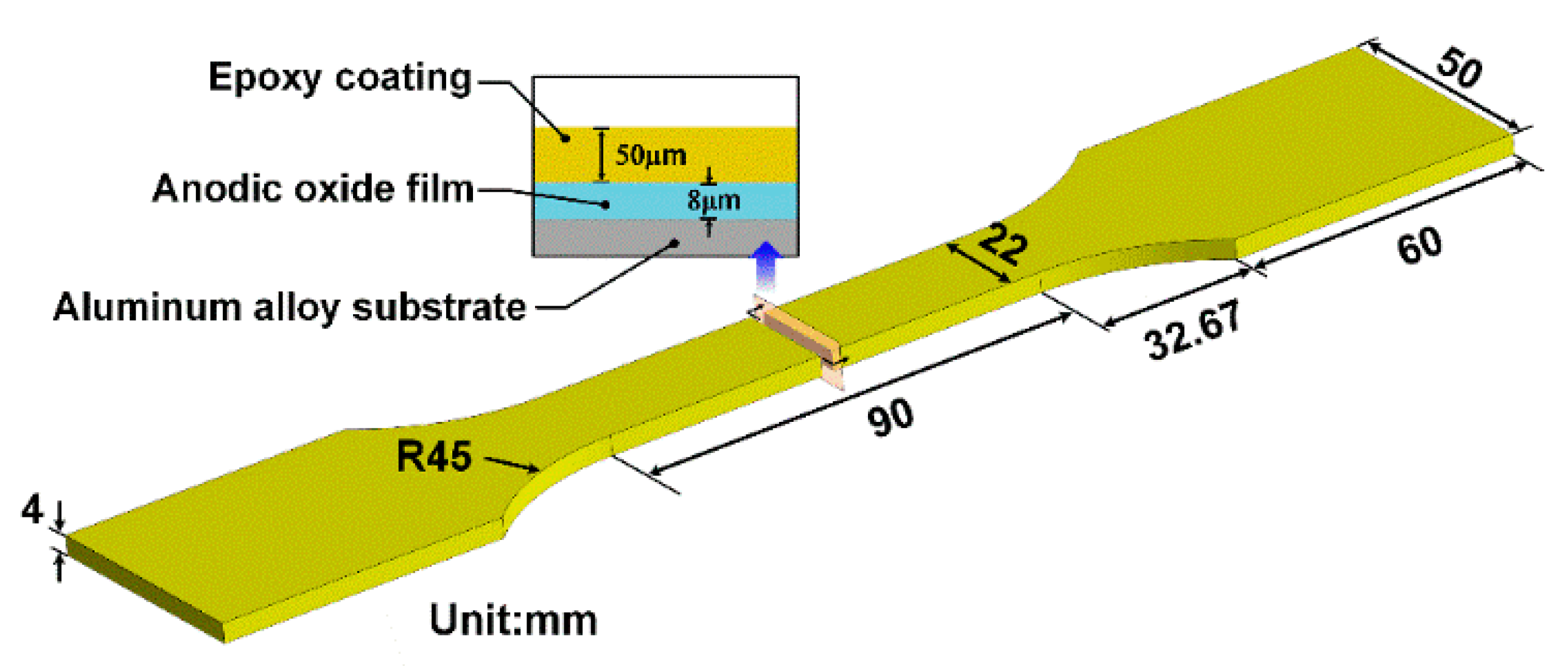

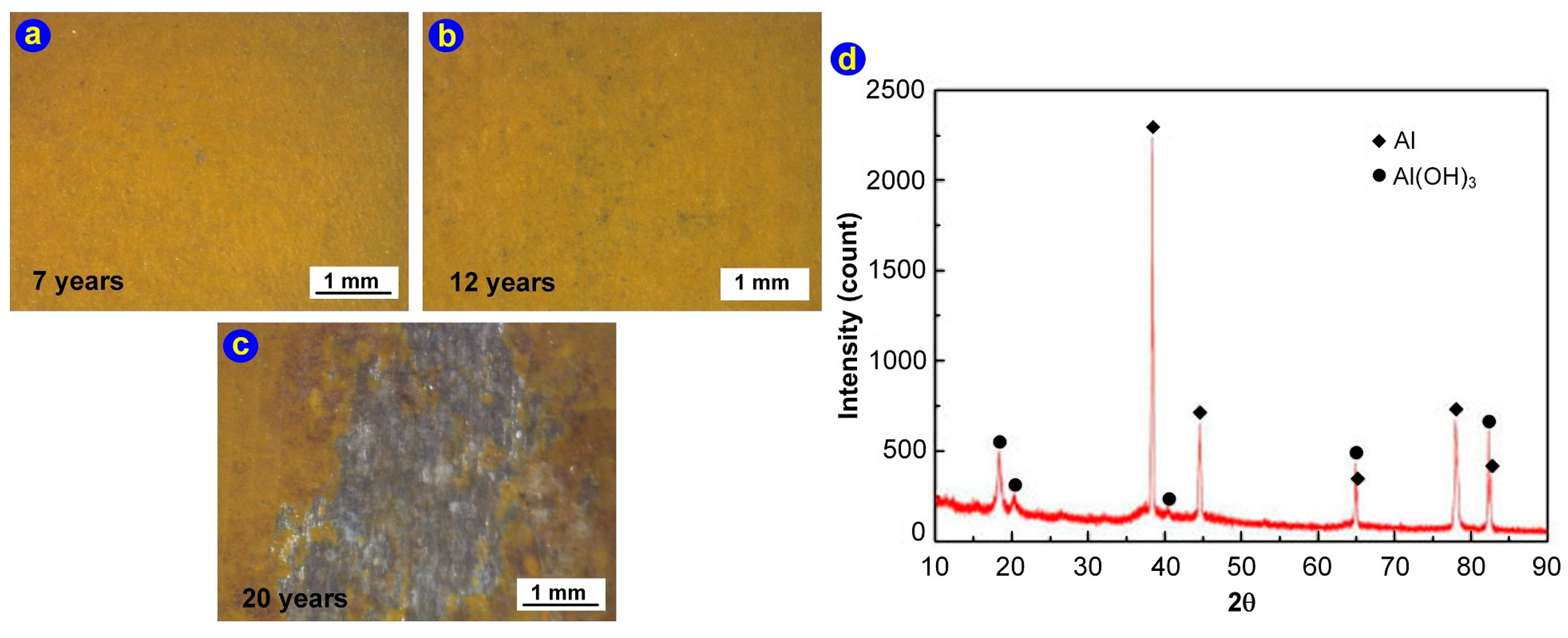
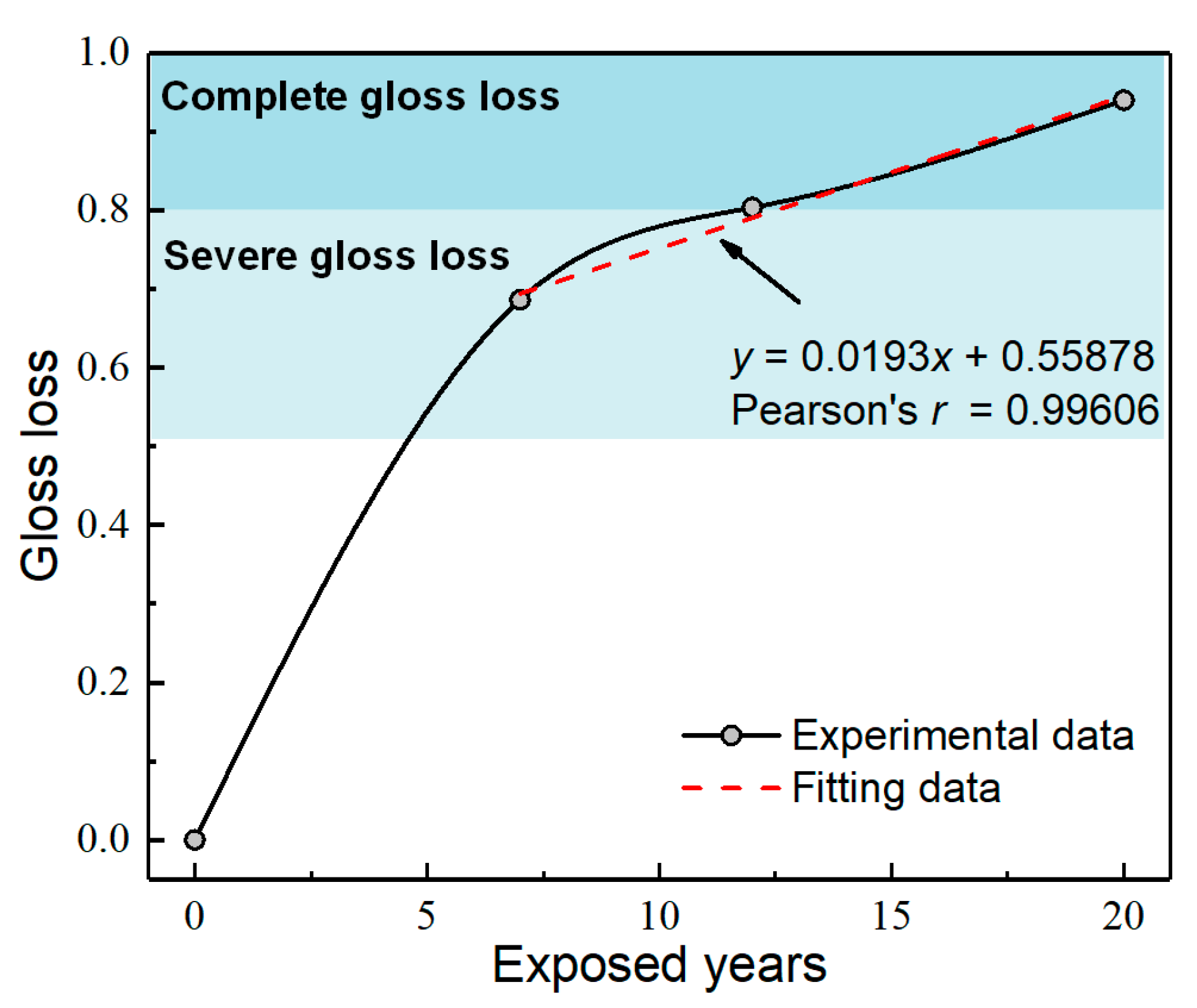
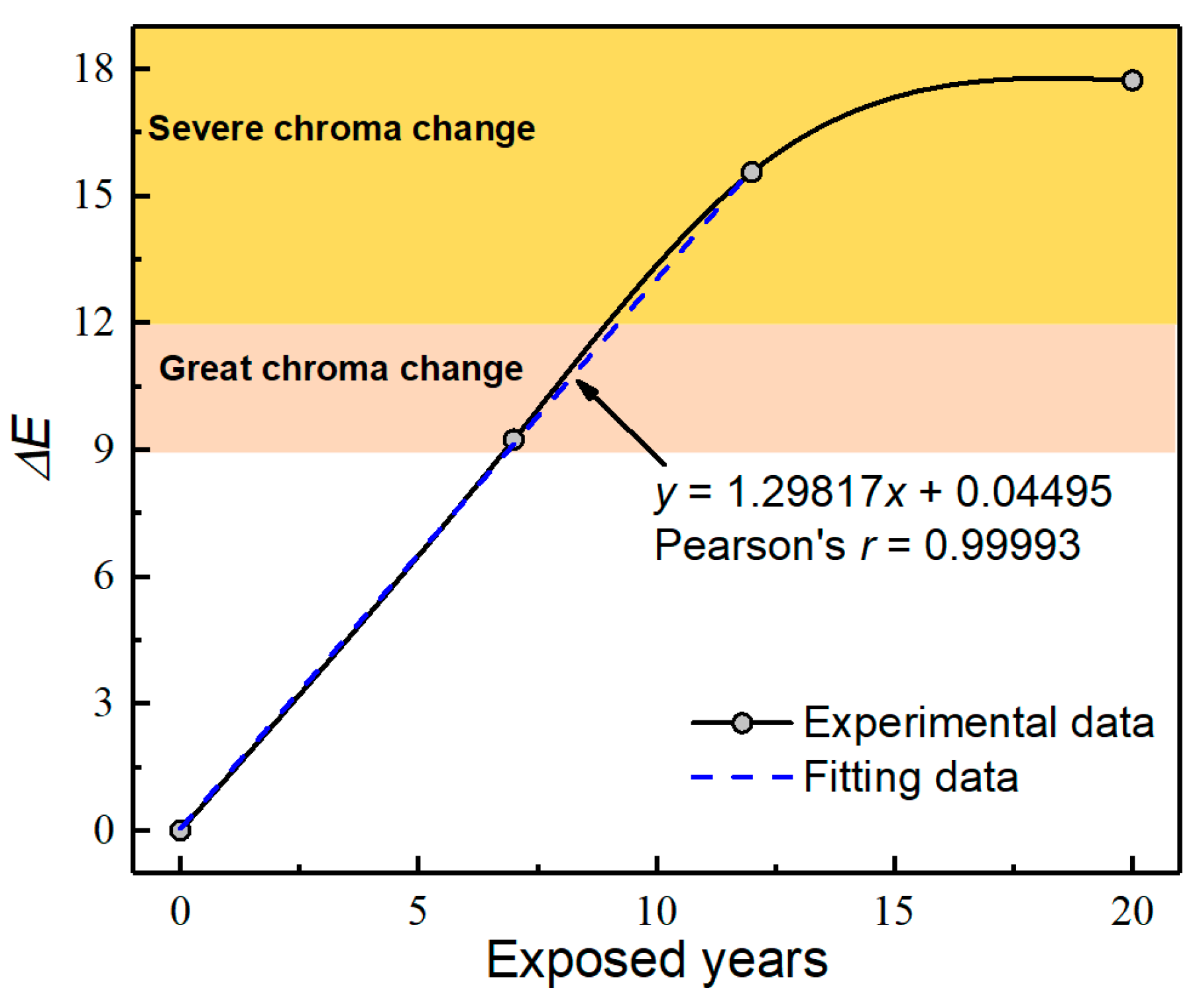
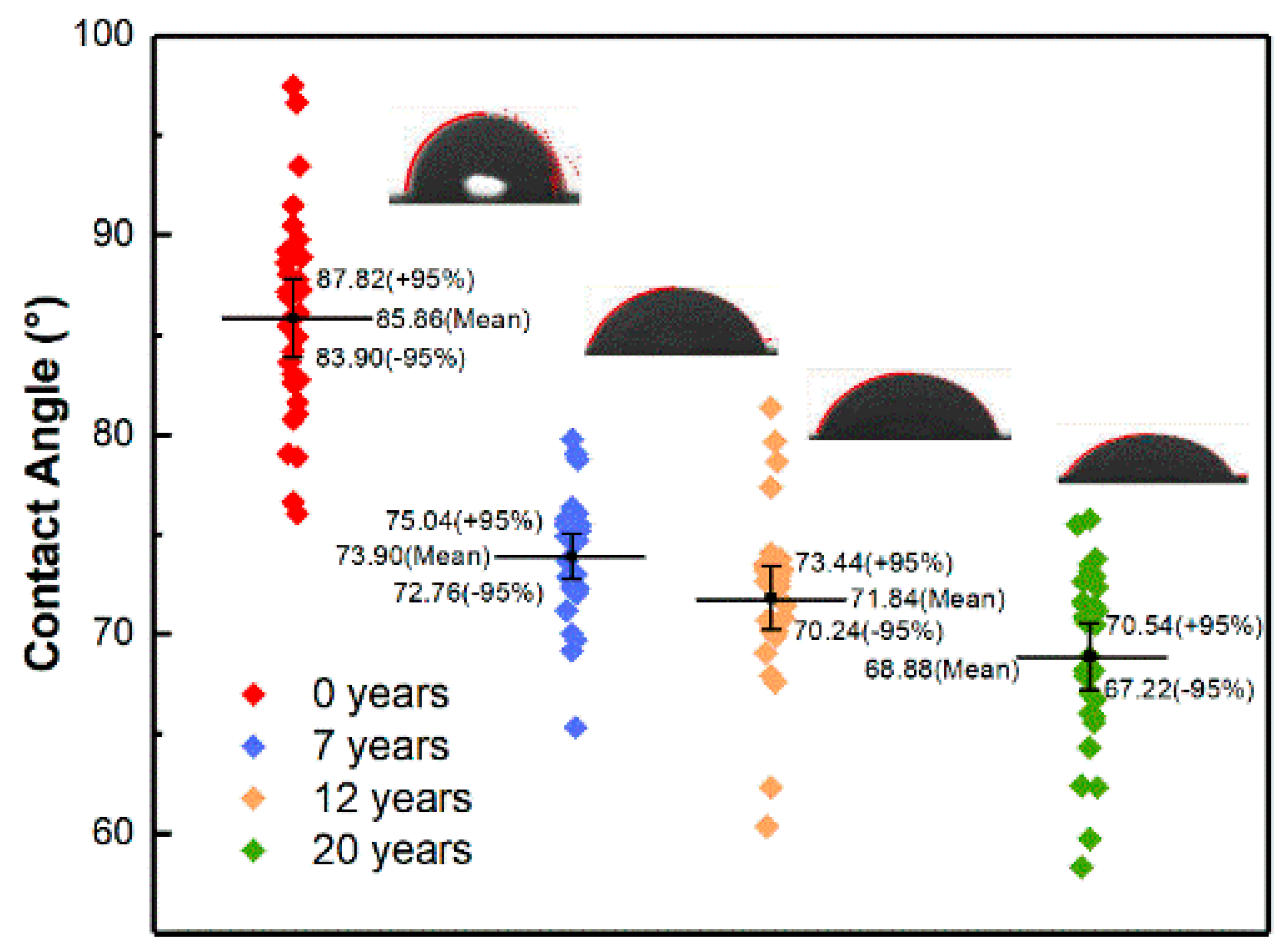
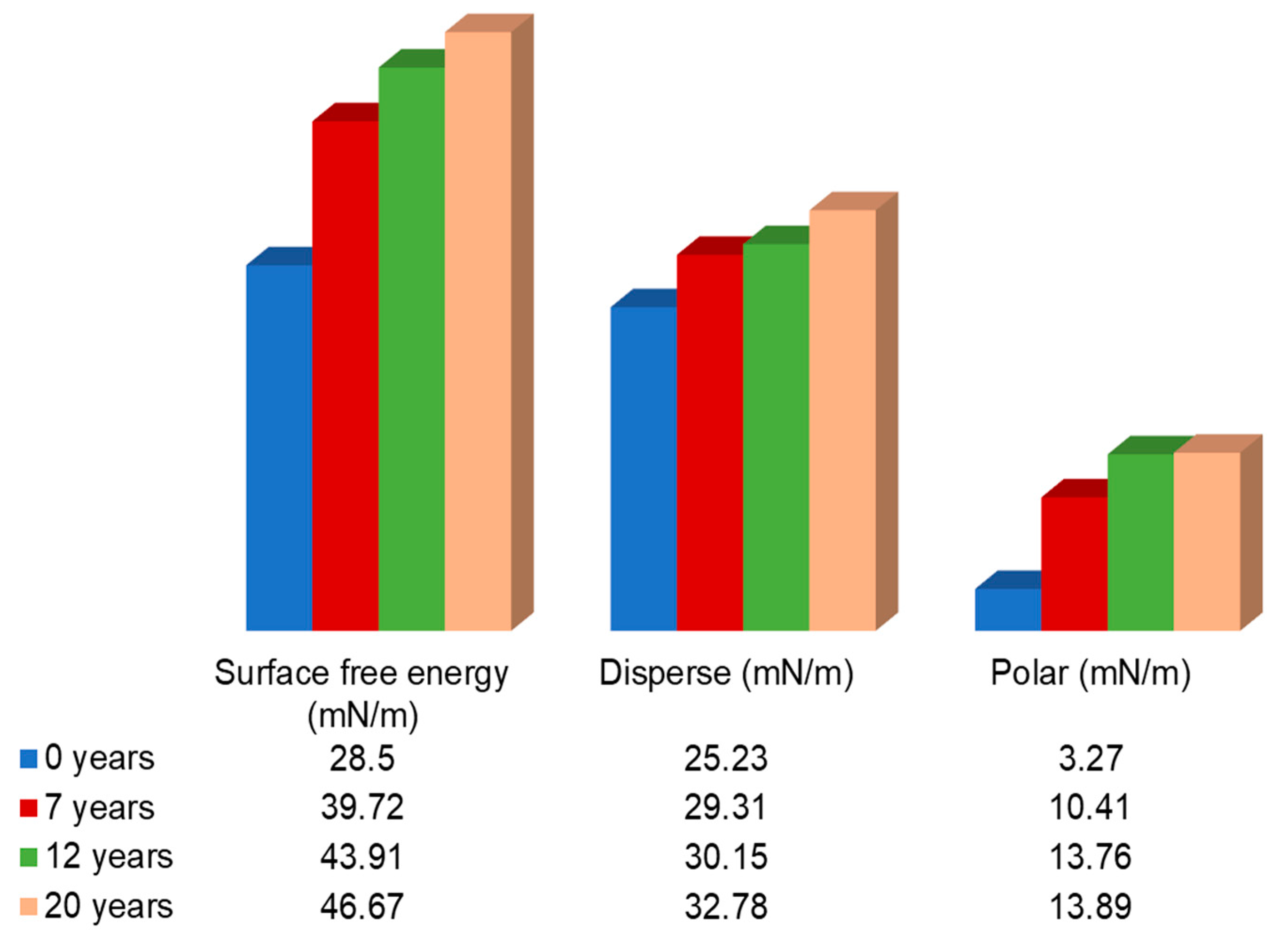
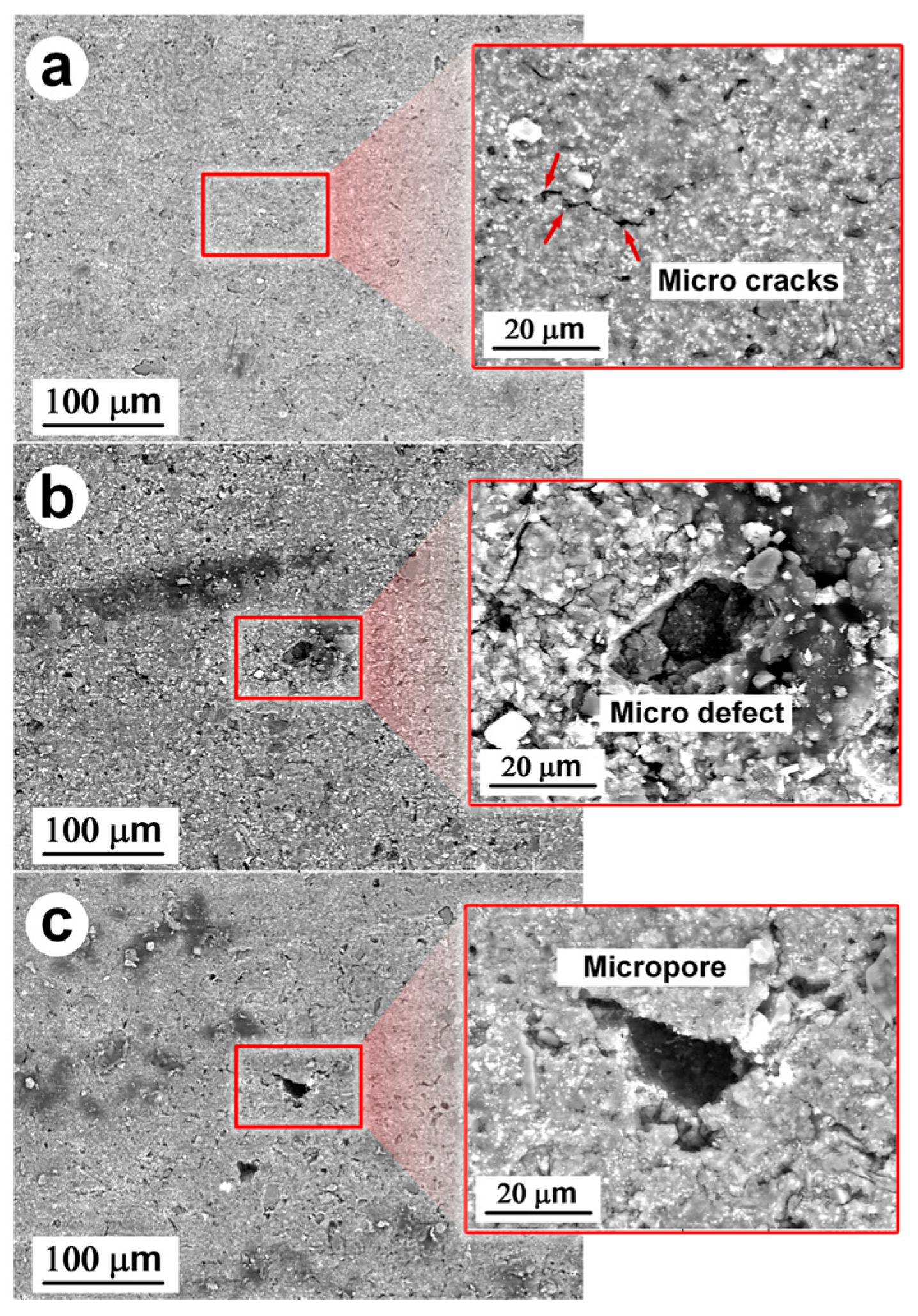

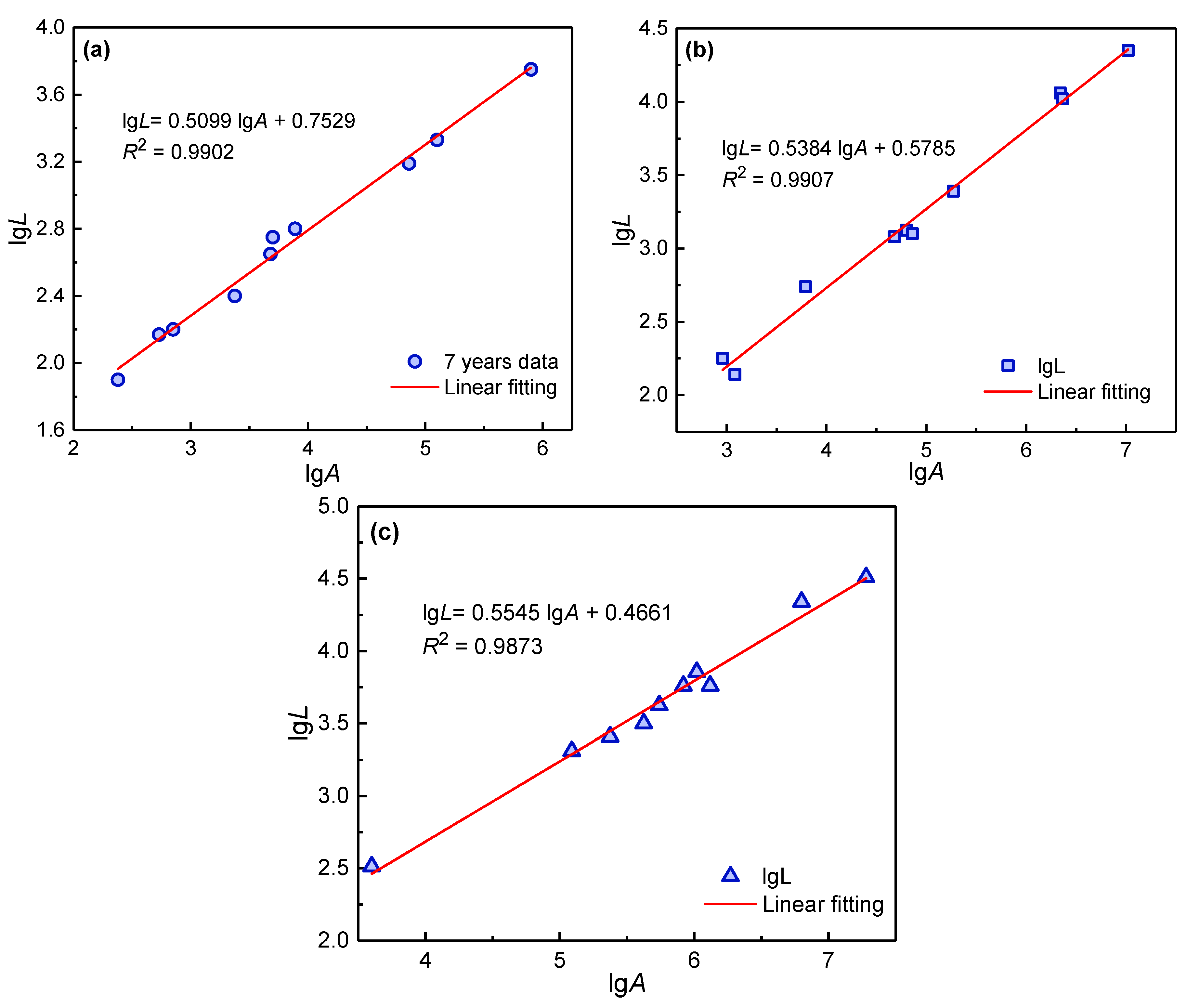
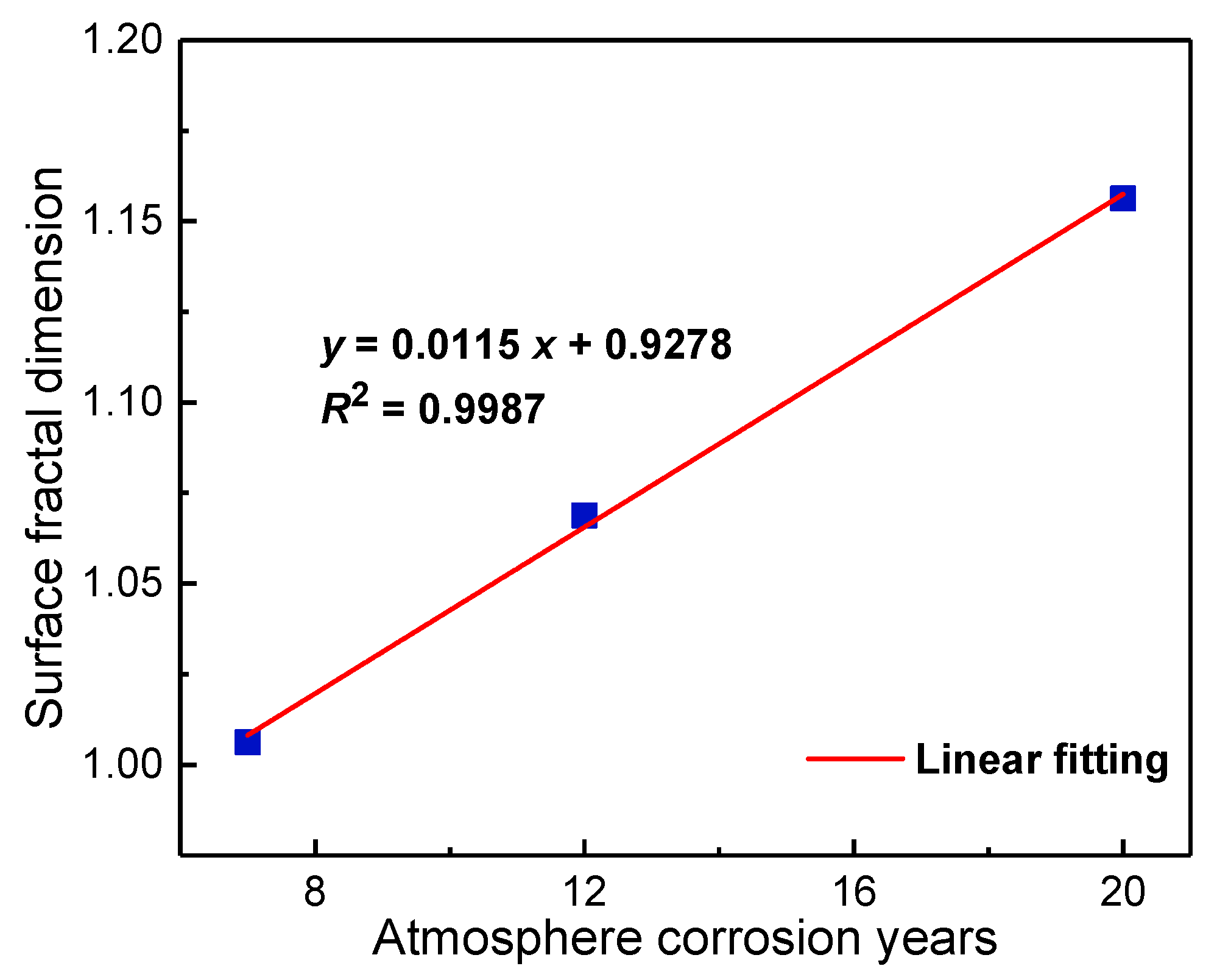

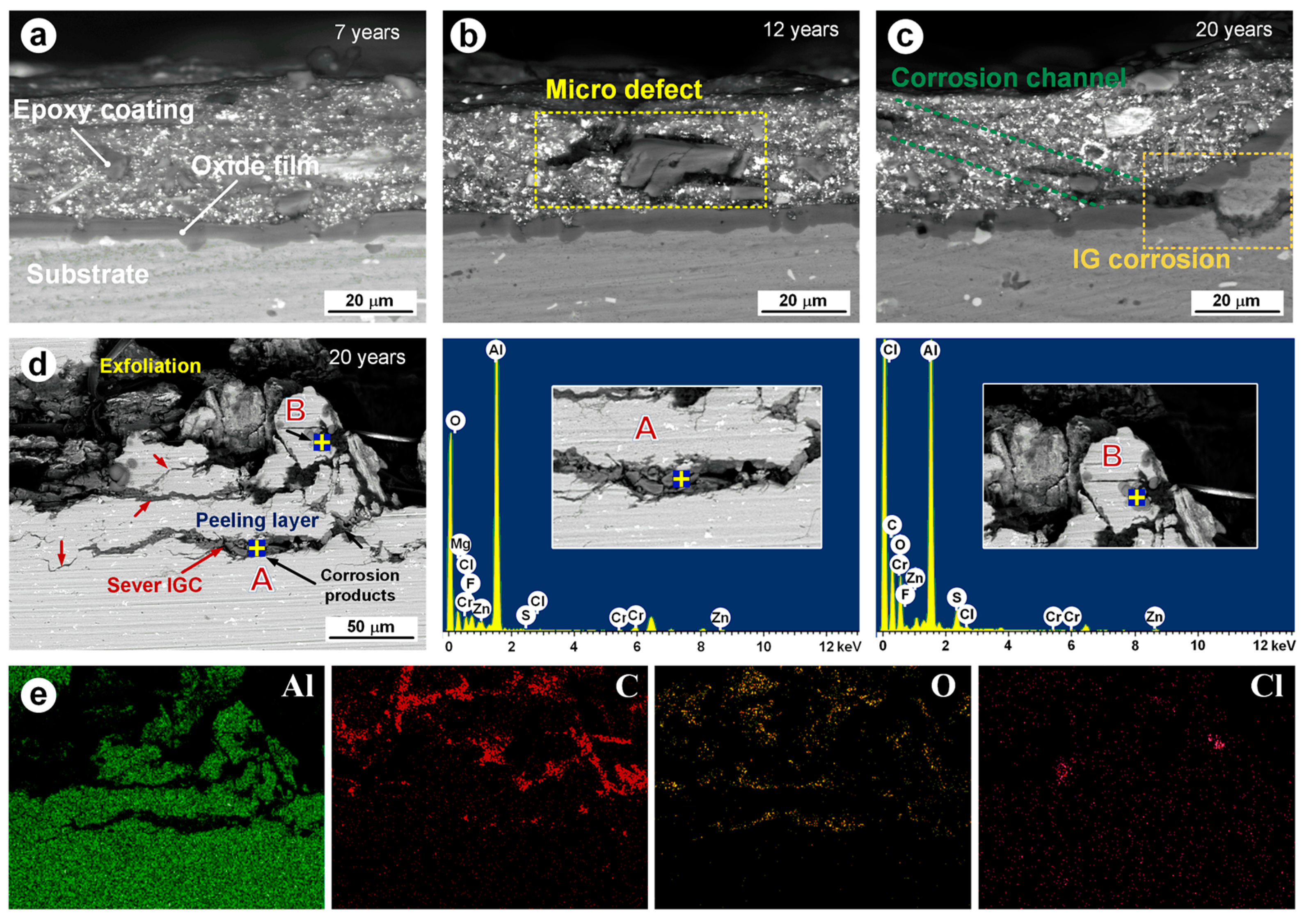
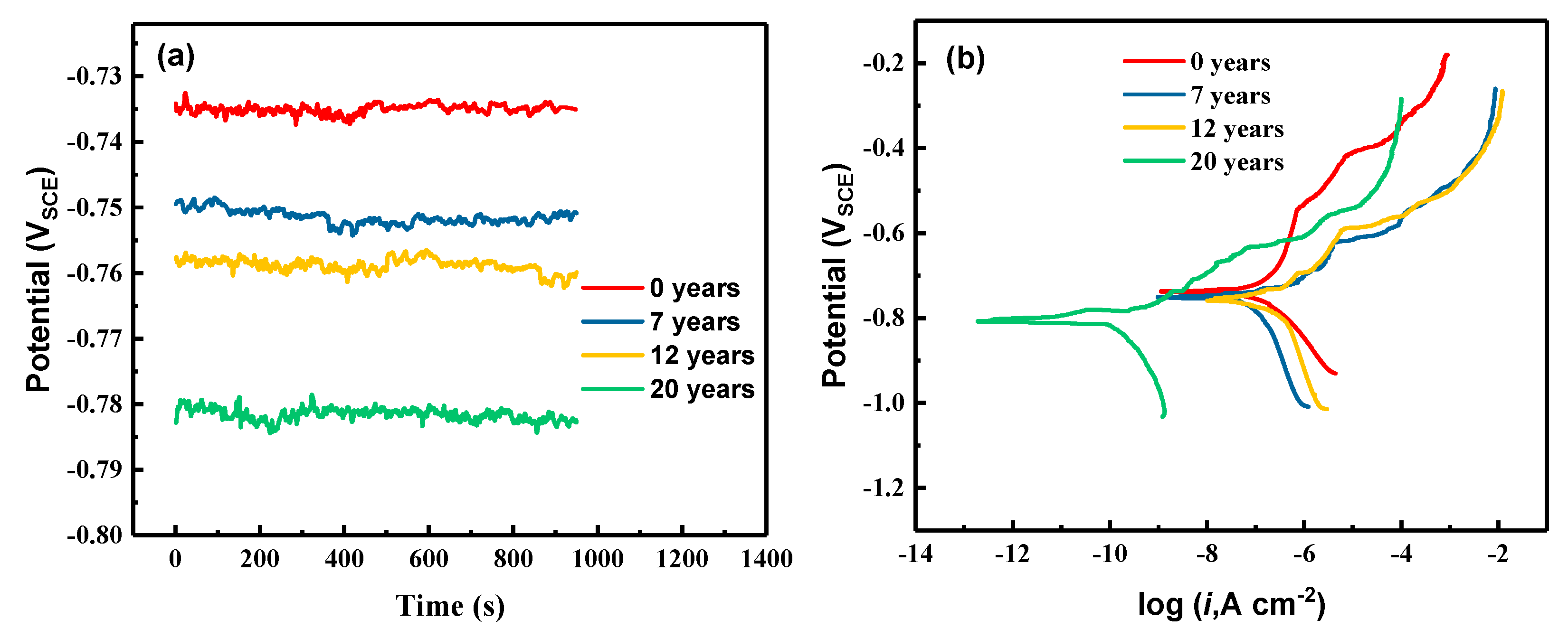




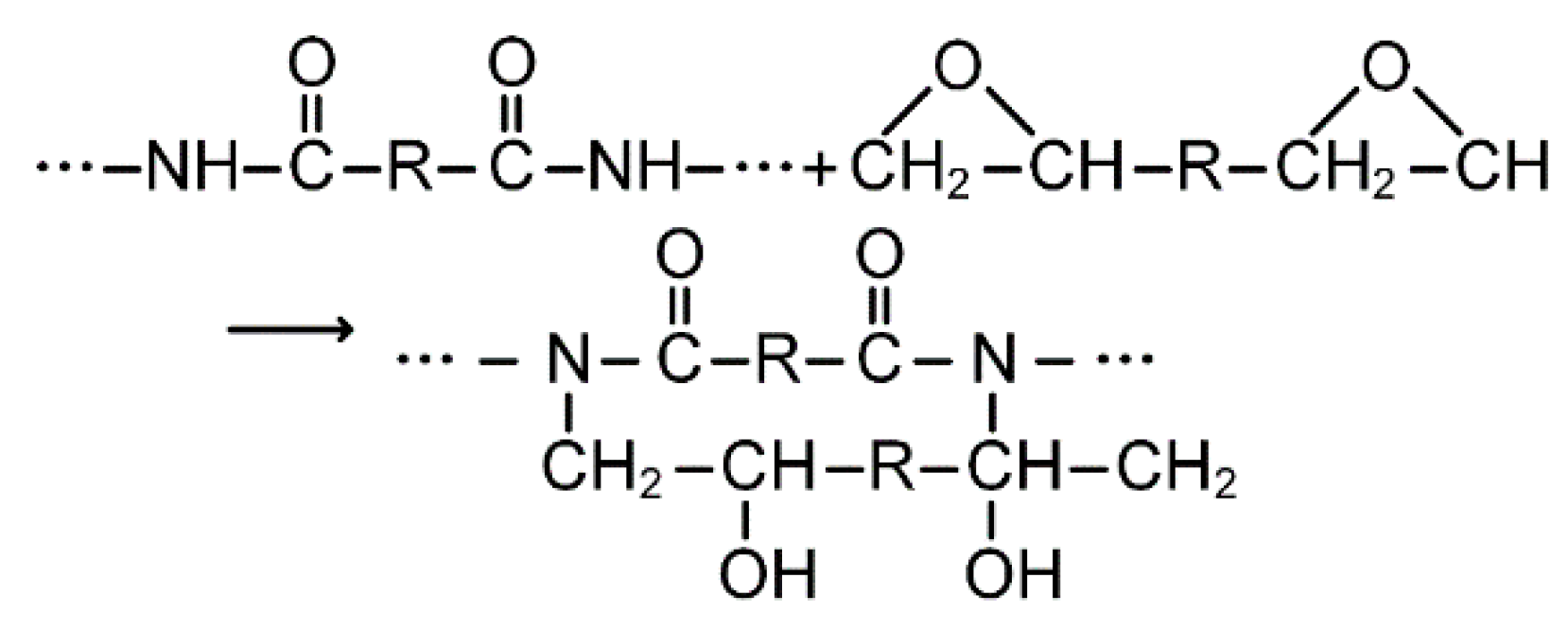

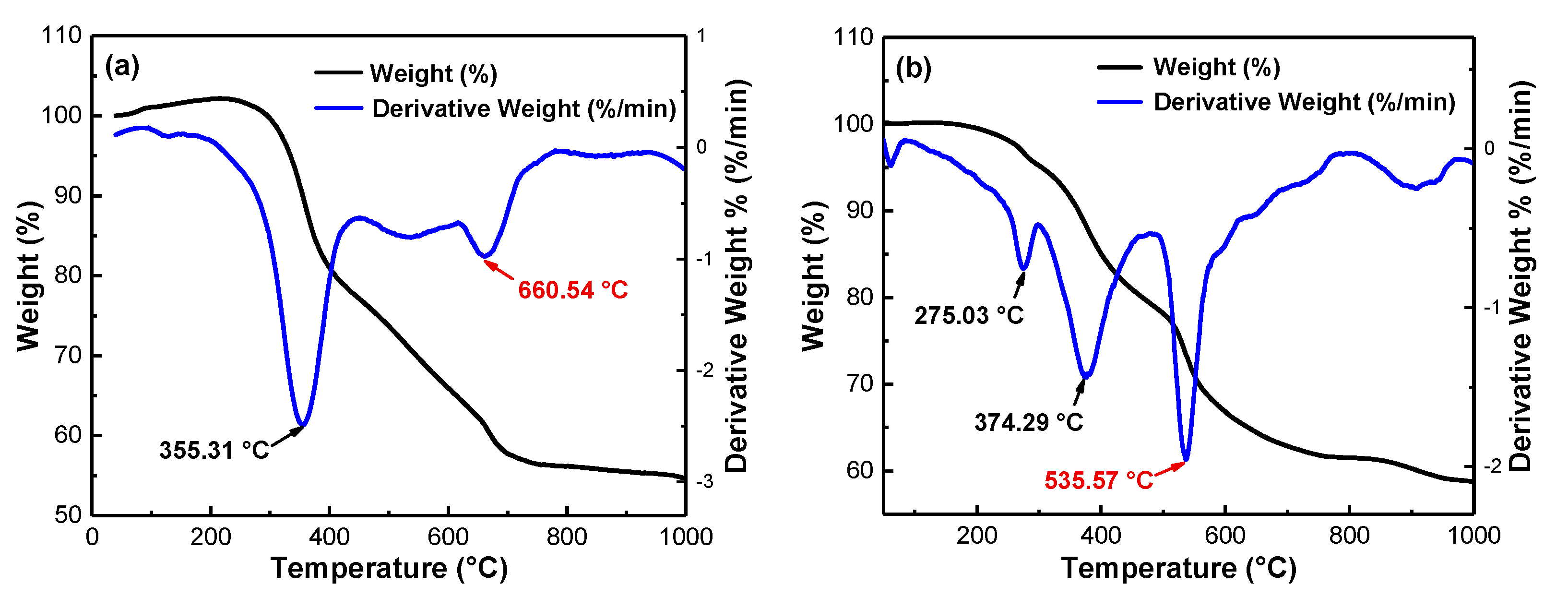
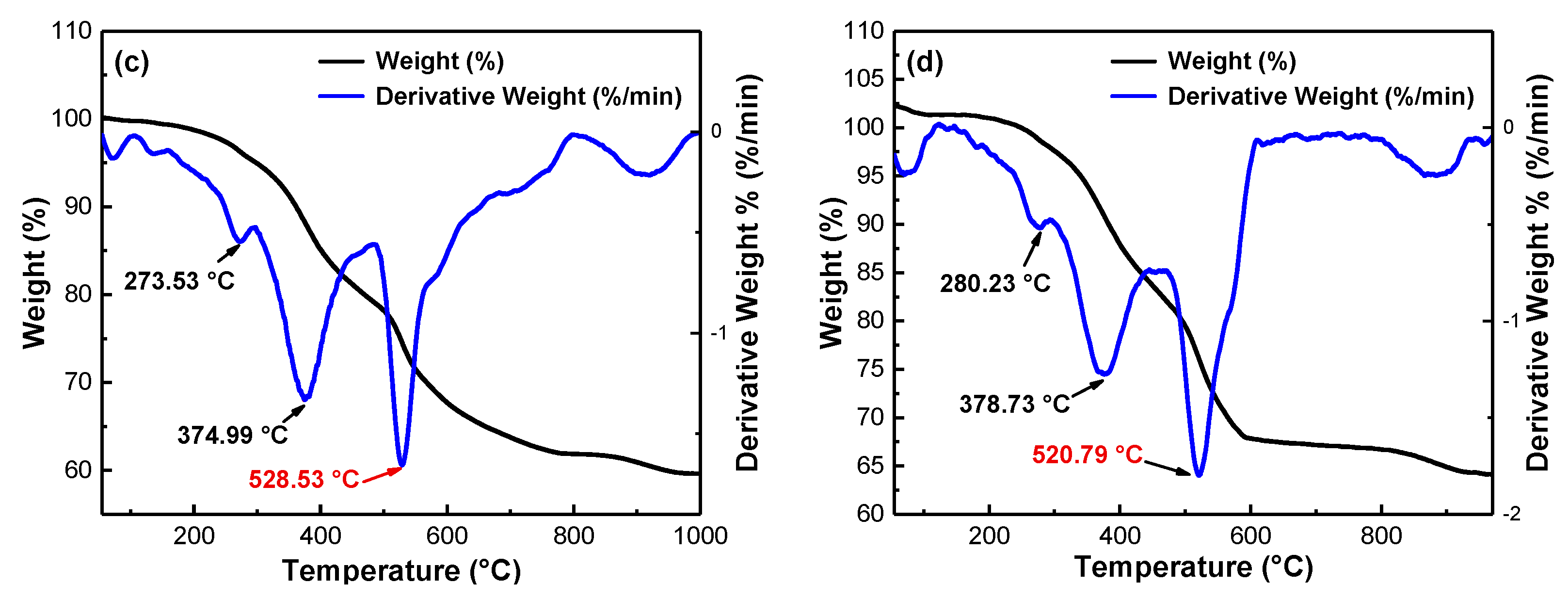
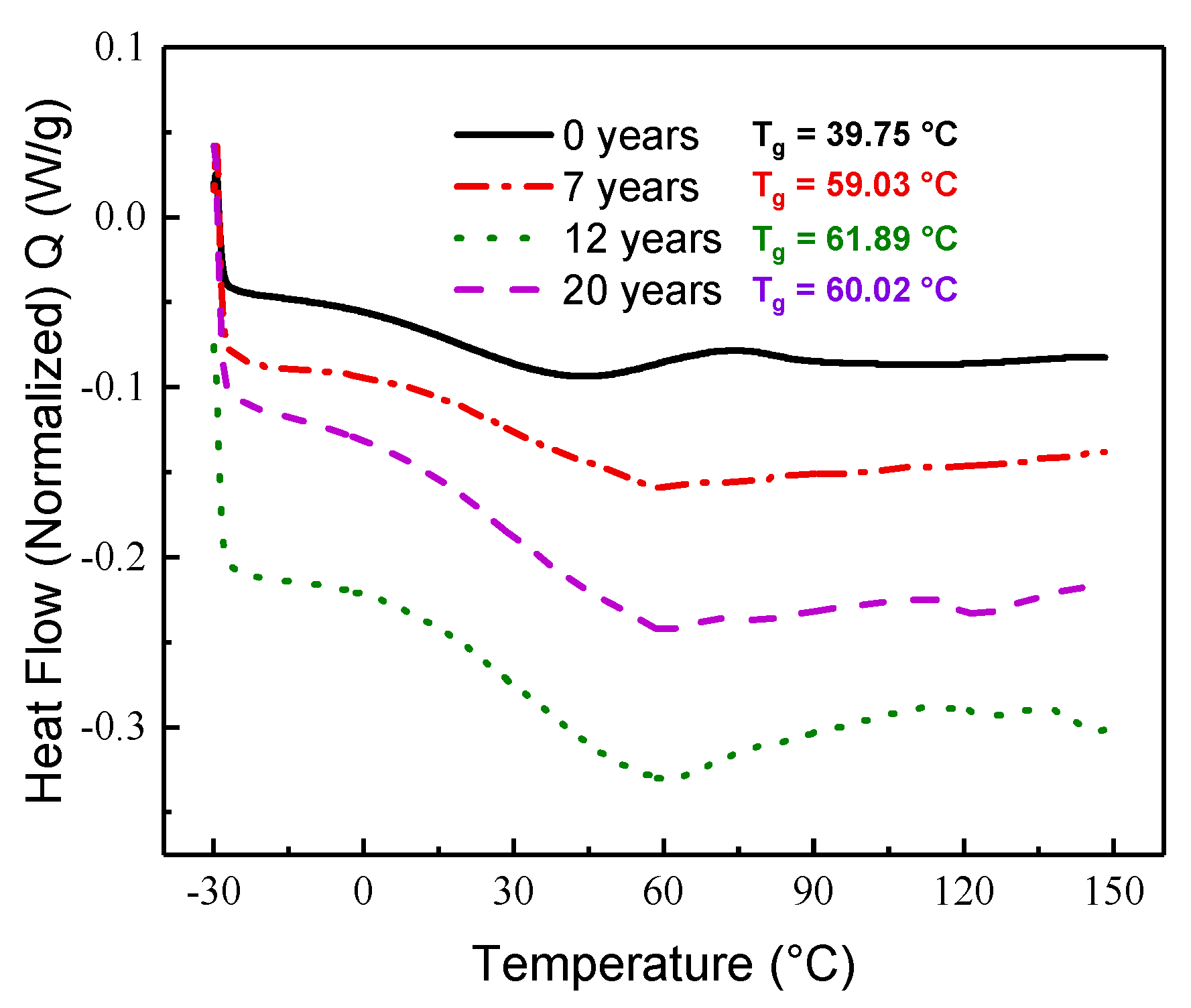

| Element | Si | Fe | Cu | Mn | Mg | Cr | Zn | Ti | Al |
|---|---|---|---|---|---|---|---|---|---|
| Weight fraction (%) | 0.50 | 0.50 | 1.68 | 0.39 | 2.31 | 0.18 | 6.01 | 0.10 | Balance |
| Environmental Characteristics | Annual Mean |
|---|---|
| Temperature (°C) | 23.9 |
| Relative humidity (%) | 87.6 |
| Amount of precipitation (mm) | 198.156 |
| Velocity of wind (m/s) | 2.431 |
| SO2 (mg/m3) | 0.045275 |
| NO2 (mg/m3) | 0.002025 |
| Cl− deposition rate (mg/m2d) | 14.5875 |
| Number | Exposed Years | Number | Exposed Years | ||||||
|---|---|---|---|---|---|---|---|---|---|
| 0 | 7 | 12 | 20 | 0 | 7 | 12 | 20 | ||
| 1 | 97.48 | 79.75 | 81.34 | 75.75 | 1 | 85.90 | 74.61 | 72.37 | 68.89 |
| 2 | 96.62 | 79.03 | 79.63 | 75.47 | 2 | 85.47 | 73.65 | 71.44 | 68.18 |
| 3 | 93.47 | 78.75 | 78.63 | 73.75 | 3 | 84.90 | 72.99 | 70.80 | 68.18 |
| 4 | 91.48 | 76.34 | 77.36 | 73.47 | 4 | 84.19 | 72.89 | 70.70 | 67.89 |
| 5 | 90.48 | 76.33 | 74.04 | 73.18 | 5 | 83.62 | 72.87 | 70.68 | 67.89 |
| 6 | 89.76 | 76.04 | 73.75 | 72.89 | 6 | 83.04 | 72.39 | 70.21 | 67.06 |
| 7 | 89.19 | 75.75 | 73.47 | 72.61 | 7 | 82.75 | 72.31 | 70.14 | 66.73 |
| 8 | 88.90 | 75.47 | 73.20 | 72.34 | 8 | 82.61 | 72.31 | 70.14 | 66.04 |
| 9 | 88.61 | 75.47 | 73.20 | 71.61 | 9 | 81.61 | 72.16 | 69.99 | 65.88 |
| 10 | 88.04 | 75.46 | 73.19 | 71.46 | 10 | 81.04 | 72.03 | 69.86 | 65.58 |
| 11 | 87.75 | 75.33 | 73.07 | 71.39 | 11 | 80.75 | 70.03 | 67.92 | 64.31 |
| 12 | 87.25 | 75.18 | 72.92 | 71.16 | 12 | 79.04 | 71.18 | 69.04 | 62.39 |
| 13 | 87.18 | 74.90 | 72.65 | 70.89 | 13 | 78.89 | 69.69 | 67.59 | 62.32 |
| 14 | 86.90 | 74.89 | 72.64 | 70.61 | 14 | 76.61 | 69.16 | 62.31 | 59.73 |
| 15 | 86.10 | 74.69 | 72.44 | 70.46 | 15 | 76.04 | 65.33 | 60.35 | 58.32 |
| Sample | Ecorr (VSCE) | icorr (μA/cm2) | Corrosion Rate (CR) (μm/year) |
|---|---|---|---|
| 0 years | −0.737 | 0.128 | 1.39 |
| 7 years | −0.748 | 0.284 | 3.09 |
| 12 years | −0.759 | 0.337 | 3.67 |
| 20 years | −0.808 | 0.919 | 10.01 |
Publisher’s Note: MDPI stays neutral with regard to jurisdictional claims in published maps and institutional affiliations. |
© 2021 by the authors. Licensee MDPI, Basel, Switzerland. This article is an open access article distributed under the terms and conditions of the Creative Commons Attribution (CC BY) license (http://creativecommons.org/licenses/by/4.0/).
Share and Cite
Zhang, T.; Zhang, T.; He, Y.; Zhang, S.; Ma, B.; Gao, Z. Long-Term Atmospheric Aging and Corrosion of Epoxy Primer-Coated Aluminum Alloy in Coastal Environments. Coatings 2021, 11, 237. https://doi.org/10.3390/coatings11020237
Zhang T, Zhang T, He Y, Zhang S, Ma B, Gao Z. Long-Term Atmospheric Aging and Corrosion of Epoxy Primer-Coated Aluminum Alloy in Coastal Environments. Coatings. 2021; 11(2):237. https://doi.org/10.3390/coatings11020237
Chicago/Turabian StyleZhang, Tianyu, Teng Zhang, Yuting He, Sheng Zhang, Binlin Ma, and Zhigang Gao. 2021. "Long-Term Atmospheric Aging and Corrosion of Epoxy Primer-Coated Aluminum Alloy in Coastal Environments" Coatings 11, no. 2: 237. https://doi.org/10.3390/coatings11020237
APA StyleZhang, T., Zhang, T., He, Y., Zhang, S., Ma, B., & Gao, Z. (2021). Long-Term Atmospheric Aging and Corrosion of Epoxy Primer-Coated Aluminum Alloy in Coastal Environments. Coatings, 11(2), 237. https://doi.org/10.3390/coatings11020237





